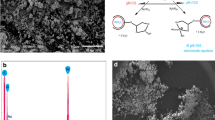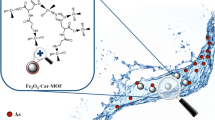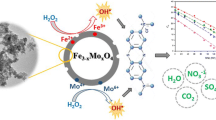Abstract
Good boron removal and isotopic separation behavior was observed on magnetic magnetite nanoparticles (MMNs) in a previous study, but the mechanism of boron adsorption and isotopic separation remains unclear. Here, experimental studies accompanied by quantum chemistry calculations were implemented for the first time to reveal the nature of boron adsorption and isotopic separation on MMN. First, the fitted peaks of Fe2p of MMN by X-ray photoelectron spectrometry (XPS) before and after adsorption showed decrease in Fe(II)/Fe(III) ratio, which validated the formation of Fe–O–B interaction. Fe–O–B bond was also observed through fitted peaks of O1s and dihydroxy complexation where MMNs prefer to adsorb [B(OH)4]−(H3BO3) at pH < = pHzpc (pH > pHzpc) identified by the ratio of integrated peaks. ATR-FTIR revealed the hydroxyl moiety as the main adsorptive group. The selectivity of MMN toward [B(OH)4]− at pH < = pHzpc and toward H3BO3 at pH > pHzpc was figured out by calculating the ratio between the integrated areas of B–O bands at different pH values. As a result, the trend of adsorption capacity as well as the isotopic separation factor with pH was well illustrated. The concluded adsorption mechanism from the experiment was further verified with the simulated adsorption energies (ΔE) and isotopic separation factors (S) calculated by DFT quantum simulation.
Graphical abstract












Similar content being viewed by others
References
Nasef M, Nallappan M, Ujang Z (2014) Polymer-based chelating adsorbents for the selective removal of boron from water and wastewater: a review. React Funct Polym 85:54–68
Geffen N, Semiat R, Eisen MS, Balazs Y (2006) Boron removal from water by complexation to polyol compounds. J Membr Sci 286:45–51
Öztürk N, Kavak D, Köse TE (2008) Boron removal from aqueous solution by reverse osmosis. Desalination 223:1–9
Scott VE (1940) Effects of boron deficiency and excess on plants. Plant Physiol 15:95–107
Hilal N, Kim GJ, Somerfield C (2011) Boron removal from saline water: a comprehensive review. Desalination 273:23–35
Cengeloglu Y, Tor A, Arslan G, Ersoz M, Gezgin S (2007) Removal of boron from aqueous solution by using neutralized red mud. J Hazard Mater 142:412–417
Wang L, Qi T, Zhang Y (2006) Novel organic–inorganic hybrid mesoporous materials for boron adsorption. Colloid Surf A 275:73–78
Guo Q, Zhang Y, Cao Y, Wang Y, Yan W (2013) Boron sorption from aqueous solution by hydrotalcite and its preliminary application in geothermal water deboronation. Environ Sci Pollut Res 20:8210–8219
Özdemir M, Kıpçak İ (2007) Boron recovery from borax sludge using solid–liquid extraction followed by sorption with a boron selective resin in column. Environ Prog 26:375–383
Yoneda Y, Uchijima T, Makishima S (1959) Separation of boron isotopes by ion exchange. J Phys Chem 63:2057–2058
Zawisky M, Bastürk M, Derntl R, Dubus F, Lehmann E, Vontobel P (2004) Non-destructive 10B analysis in neutron transmission experiments. Appl Radiat Isot 61:517–523
Masoudi SF, Rasouli FS, Ghasemi M (2017) BNCT of skin tumors using the high-energy D-T neutrons. Appl Radiot Isot 122:158–163
Wu X, Bai P, Guo X, He N (2014) 2,4-Difluoro anisole: a promising complexing agent for boron isotopes separation by chemical exchange reaction and distillation. J Radioanal Nucl Ch 300:897–902
Nagasawa H, Iizuka A, Yamasaki A, Yanagisawa Y (2011) Utilization of bipolar membrane electrodialysis for the removal of boron from aqueous solution. Ind Eng Chem Res. 50:6325–6330
Jjiang YX (2008) Technologies for boron removal. Ind Eng Chem Res 47:16–24
Guan Z, Lv J, Bai P, Guo X (2016) Boron removal from aqueous solutions by adsorption—a review. Desalination 383:29–37
Zhang N, Lyu J, Bai P, Guo X (2018) Boron isotopic separation with pyrocatechol-modified resin by chromatography technology: experiment and numerical simulation. J Ind Eng Chem 57:244–253
Lyu J, Zeng Z, Zhang N, Liu H, Bai P, Guo X (2017) Pyrocatechol-modified resins for boron recovery from water: synthesis, adsorption, and isotopic separation studies. React Funct Polym 112:1–8
Lyu J, Liu H, Zhang J, Zeng Z, Peng B, Guo X (2017) Metal–organic frameworks (MOFs) as highly efficient agents for boron removal and boron isotope separation. Rsc Adv 7:16022–16026
Chen T, Wang Q, Lyu J, Bai P, Guo X (2020) Boron removal and reclamation by magnetic magnetite (Fe3O4) nanoparticle: An adsorption and isotopic separation study. Sep Purif Technol 231:115930
Peak D, Luther GW, Sparks DL (2003) ATR-FTIR spectroscopic studies of boric acid adsorption on hydrous ferric oxide. Geochim Cosmochim Acta 67:2551–2560
Rajput S, Pittman CU Jr, Mohan D (2016) Magnetic magnetite (Fe3O4) nanoparticle synthesis and applications for lead (Pb2+) and chromium (Cr6+) removal from water. J Colloid Interface Sci 468:334–346
Su C, Suarez D (1995) Coordination of adsorbed boron: a FTIR spectroscopic study. Environ Sci Technol 29:302–311
Ji H, Du P, Zhao D, et al. (2020) 2D/1D graphitic carbon nitride/titanate nanotubes heterostructure for efficient photocatalysis of sulfamethazine under solar light: catalytic “hot spots” at the rutile–anatase–titanate interfaces. Appl Catal B-Environ 263:118357
Ma M, Chen L, Zhao J, Liu W, Ji H (2019) Efficient activation of peroxymonosulfate by hollow cobalt hydroxide for degradation of ibuprofen and theoretical study. Chin Chem Lett 30:2191–3195
Zhou F, Zhang J, Bai P (2018) Theoretical study on complexes and reactions of boron isotopic exchange separation with fluorinated anisoles as novel donors. J Radioanal Nucl Chem 316:587–594
Rath S, Sinha N, Sahoo H, Das B, Mishra BK (2014) Molecular modeling studies of oleate adsorption on iron oxides. Appl Surf Sci 295:115–122
Zhou F, Zhang J, Bai P, Guo X (2016) Theoretical calculation of boron isotopic separation factors in ion-exchange chromatography. J Chem Eng Data 62:525–531
Zuo J, Spence JC, Petuskey W (1990) Charge ordering in magnetite at low temperatures. Phys Rev B Condens Matter 42:8451–8464
Parr R, Gadre S (1979) Local density functional theory of atoms and molecules. P Natl Acad Sci USA 76:2522–2526
Segall M, Lindan D (2002) First-principles simulation: ideas, illustrations and the CASTEP code. J Phys Condens Matter 14:2717–2744
Perdew J, Burke K, Wang M (1996) Generalized gradient approximation for the exchange-correlation hole of a many-electron system. Phys Rev B Condens Matter 54:16533–16539
Ernzerhof M, Scuseria G (1999) Assessment of the Perdew-Burke-Ernzerhof exchange-correlation functional. J Chem Phys 110:5029–5030
Kovács SÁ, Lo CS (2010) Electronic structure and charge ordering in magnetite: implications for the Fe3O4 (001)–water interface. Mol Simulat 36:1289–1296
Oi T, Yanase S (2001) Calculations of reduced partition function ratios of hydrated monoborate anion by the ab initio moleculaSr orbital theory. J Nucl Sci Technol 38:429–432
Vanderbilt D (1985) Optimally smooth norm-conserving pseudopotentials. Phys Rev B Condens Matter 32:8412–8415
Edzwald JK, Haarhoff J (2011) Seawater pretreatment for reverse osmosis: chemistry, contaminants, and coagulation. Water Res 45:5428–5440
Chowdhury SR, Yanful EK, Pratt AR (2012) Chemical states in XPS and Raman analysis during removal of Cr (VI) from contaminated water by mixed maghemite-magnetite nanoparticles. J Hazard Mater 235–236:246–256
Afkhami A, Moosavi R (2010) Adsorptive removal of Congo red, a carcinogenic textile dye, from aqueous solutions by maghemite nanoparticles. J Hazard Mater 174:398–403
Wu Y, Chen R, Liu H, Wei Y, Wu D (2013) Feasibility and mechanism of p -nitrophenol decomposition in aqueous dispersions of ferrihydrite and H2O2 under irradiation. React Kinet Mech Cat 110:87–99
Honma T, Sato R, Benino Y, Komatsu T (2000) Electronic polarizability, optical basicity and XPS spectra of Sb2O3–B2O3 glasses. J Non-Cryst Solids 272:1–13
Fujii T, Groot F, Sawatzky GA (1999) In situ XPS analysis of various iron oxide films grown by NO2—assisted molecular-beam epitaxy. Phys Rev B 4:3195–3202
Gebhardt J, Koch RJ, Zhao W, Höfert O, Gotterbarm K (2013) Growth and electronic structure of boron-doped graphene. Phys Rev B 87:1–9
Lakshminarayana G, Baki SO, Lira A et al (2017) X-ray photoelectron spectroscopy (XPS) and radiation shielding parameters investigations for zinc molybdenum borotellurite glasses containing different network modifiers. J Mater Sci 52:7394–7414. https://doi.org/10.1007/s10853-017-0974-0
Hu Q, Liu Y, Gu X, Zhao Y (2017) Adsorption behavior and mechanism of different arsenic species on mesoporous MnFe2O4 magnetic nanoparticles. Chemosphere 181:328–336
Li X, Liu R, Wu S, Liu J, Cai S, Chen D (2011) Efficient removal of boron acid by N-methyl-D-glucamine functionalized silica-polyallylamine composites and its adsorption mechanism. J Colloid Interface Sci 361:232–237
Pistorius T (1959) Potential function of boric acid. J Chem Phys 31:1454–1457
Karahan S, Yurdakoc M, Seki Y, Yurdakoc K (2006) Removal of boron from aqueous solution by clays and modified clays. J Colloid Interface Sci 293:36–42
Fei P, Liao L, Cheng B, Song J (2017) Quantitative analysis of cellulose acetate with a high degree of substitution by FTIR and its application. Anal Methods 9:6194–6201
Rafiee M, Nematollahi D (2008) Electrochemical study of catechol–boric acid complexes. Electrochim Acta 53:2751–2756
Meng MX, Korfiatis GP, Jing C (2006) Adsorption mechanism of arsenicon nanocrystalline titanium dioxide. Environ Sci Technol 40:1257–1262
Oi T, Shimazaki H, Ishii R, Hosoe M (1997) Boron isotope fractionation in liquid chromatography with boron-specific Resins as column packing material. Sep Sci 32:1821–1834
Tao Y, Wen X, Ren J, Yong-Wang L, Wang J, Huo C (2010) Surface structures of Fe3O4 (111), (110), and (001)—a density functional theory study. Chem Tech Fuels Oil 38:121–128
Wang H, Sun X, Han E (2018) The Interactions between high temperature water and Fe3O4 (111) by first-principles molecular dynamics simulation. Int J Electrochem Sci 13:2430–2440
Mulakaluri N, Pentcheva R, Wieland M, Moritz W, Scheffler M (2009) Partial dissociation of water on Fe3O4 (001): adsorbate induced charge and orbital order. Phys Rev Lett 103:1–4
Roldan A, de Leeuw NH (2017) A kinetic model of water adsorption, clustering and dissociation on the Fe3S4 {001} surface. Phys Chem Chem Phys 19:12045–12055
Acknowledgements
This project was supported by National Natural Science Foundation of China (No. 22078235, No. 22008176) and China Postdoctoral Science Foundation (2019M661022).
Author information
Authors and Affiliations
Contributions
The manuscript was written through the contribution of all authors. All authors have given approval to the final version of the manuscript.
Corresponding author
Ethics declarations
Conflict of interest
The authors declare no competing financial interest.
Additional information
Handling Editor: Dale Huber
Publisher's Note
Springer Nature remains neutral with regard to jurisdictional claims in published maps and institutional affiliations.
Electronic supplementary material
Below is the link to the electronic supplementary material.
10853_2020_5546_MOESM1_ESM.docx
Supplementary file1. Details of prepared MMN, adsorption schematic diagram,characterization results, model diagram of density function theory (DFT) calculationswere described as Fig. S1–S16, Table S1–S7. (DOC 1026 kb)
Rights and permissions
About this article
Cite this article
Chen, T., Lyu, J., Wang, Q. et al. Mechanistic study on boron adsorption and isotopic separation with magnetic magnetite nanoparticles. J Mater Sci 56, 4624–4640 (2021). https://doi.org/10.1007/s10853-020-05546-x
Received:
Accepted:
Published:
Issue Date:
DOI: https://doi.org/10.1007/s10853-020-05546-x




